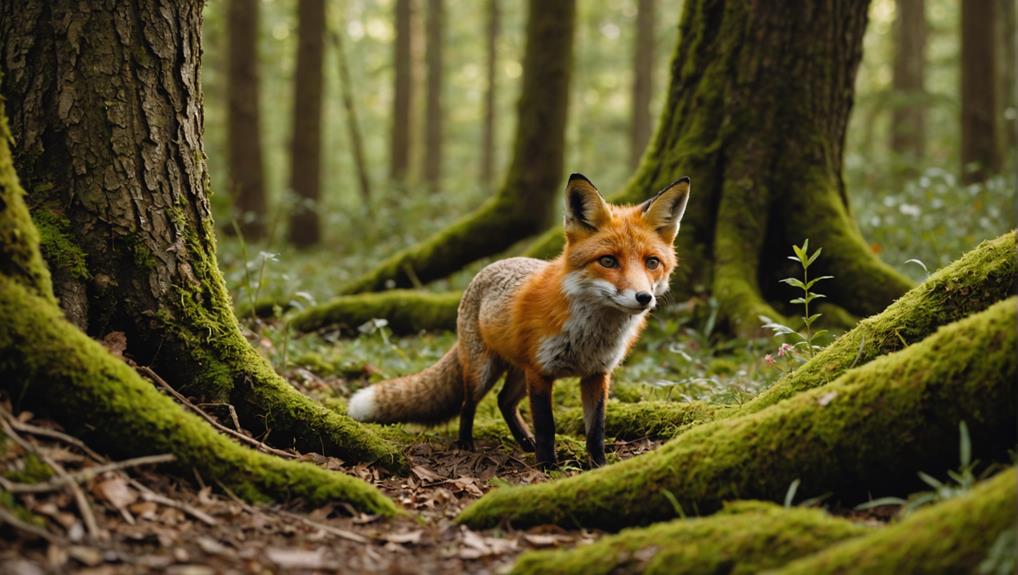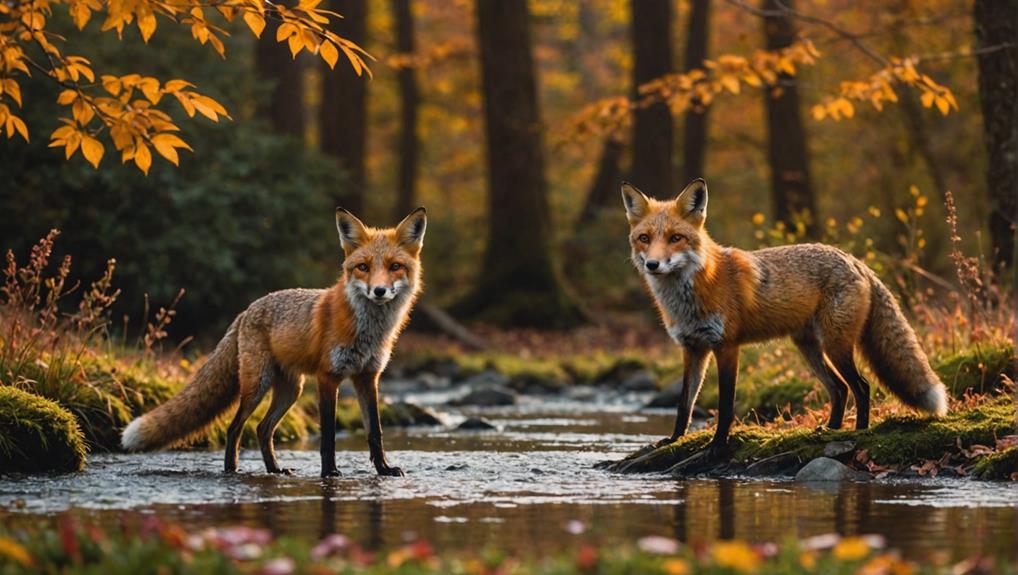During mating season, foxes get super busy! You'll see males roaming around, barking, and marking their territory to attract the ladies. Vixens are only ready to mate for about one to six days, so it's a competitive time! These clever creatures engage in playful courtship rituals and let loose with lots of vocalizations, especially in January and February. After mating, vixens prepare dens for their pups, which are born blind and need lots of care. It's a wild mix of romance and parenting that you wouldn't want to miss out on—stick around to learn even more exciting details!
Contents
Mating Rituals and Courtship
During mating season, red foxes display intriguing mating rituals and courtship behaviors that are fundamental for their reproductive success. You'll notice males roaming around, calling out with screams and barks, all to attract receptive females.
The vixen, or female fox, is ready for mating for just one to six days, and during this time, males often take on the role of guardians, ensuring they don't miss out on a chance to mate. Remarkably, like the Arctic fox, red foxes also engage in scent marking as part of their courtship, which plays an essential role in communication and territory establishment mastery of scent marking.
As they court, both males and females engage in unique courtship behaviors, like increased scent marking and playful postures. This isn't just a dance; it's a significant part of mate selection.
With multiple males vying for a single female, competition heats up, and you can see the social hierarchy at play. The strongest contenders often rise to the top, showcasing their best moves.
When they finally do mate, a mesmerizing copulatory lock occurs, allowing both partners to stay connected for a while. This not only boosts fertilization chances but offers a bit of safety from potential predators.
Territorial Behavior and Conflicts
As mating season unfolds, male foxes become highly active, patrolling their territories in search of receptive females.
You'll notice that territorial behaviors ramp up greatly, with urban foxes exhibiting strong social structures to communicate and establish dominance. Adult foxes vocalize and mark their boundaries, trying to establish themselves as the dominant male.
It's not all fun and games, though; aggressive interactions happen more often during this time. With heightened competition for food and mating opportunities, tensions can lead to injuries, like bite wounds, which is no laughing matter.
Interestingly, young males usually leave their natal territories first during the peak dispersal period in October. They want to avoid the fierce competition from adults, who defend their resources with tenacity.
Unfortunately, all this increased movement can lead to more road deaths, as foxes cross streets while searching for mates. This adaptation strategy highlights the resilience of urban foxes as they navigate their environments.
So, while they're out there trying to find love, they're also inadvertently putting themselves at risk.
It's a wild time in the fox world, filled with drama and determination. Understanding their territorial behaviors gives us a glimpse into the challenges these clever creatures face during mating season.
It's nature's way of keeping things exciting, isn't it?
Vocal Communication in Mating Season

During mating season, you might hear some pretty wild sounds coming from foxes, and trust me, it's not just your neighbor's dog barking up a storm!
Males are out there screaming and barking to attract females and let other males know who's boss in the neighborhood.
It's like a vocal showdown, where every yip and howl helps them communicate their readiness to mate and assert their territory—who knew love could be so loud?
Mating Calls and Sounds
When foxes enter mating season, their vocalizations become an essential part of their courtship ritual. Male foxes kick off the season with loud barks and screams, aiming to catch the attention of receptive females. It's like a concert where the loudest singer gets the spotlight!
Vixens, in turn, respond with their own cries, creating a thrilling exchange that fosters communication and competitive courtship among multiple suitors. During this time, you may also notice increased territorial behavior, as male foxes assert their presence in the area, showcasing their adaptability to local environments habitat diversity.
As January and February roll around, you'll notice these vocalizations peak, marking a time when males search for local females with heightened activity. It's a bit like a dating frenzy! The sounds they make not only show readiness but also change based on how receptive the females are. Male foxes even sprinkle in some urination marking to signal their territory, making sure everyone knows they're in the game.
During the copulatory phase, the vocalizations can get intense, featuring agonistic screams that serve as warning calls to potential predators.
Territorial Vocalizations and Behavior
Mating season brings heightened vocalizations and assertive behavior from male foxes, showcasing their territorial instincts. During this exciting time, you'll hear them screaming and barking, all to attract females and fend off rivals. It's like a wild, furry competition!
These vocalizations serve a dual purpose: they signal their presence and warn other males to stay away from their turf.
Females, known as vixens, also play a role in this vocal showdown. They produce specific sounds to show they're ready to mate, which can really heat up the competition among the males. As they strut their stuff, both sexes engage in scent marking, leaving their unique scents around their territories. It's a sort of olfactory billboard saying, "Hey, I'm here!"
However, this increase in vocal and roaming behaviors can lead to some unintended consequences. More movement means a higher risk of accidents, especially on roads.
Breeding Patterns and Offspring
The intricate dance of courtship among foxes showcases their unique breeding patterns and the challenges they face. During the breeding season, which typically occurs from January to February, vixens become receptive for about three weeks. This sparks competitive courtship among males, all enthusiastic to win her favor.
Once they mate, the gestation period lasts around 51-54 days, leading to the birth of adorable pups. In urban areas, things get a bit wild. Studies show that about one-third of red fox litters might've multiple fathers, highlighting their non-monogamous tendencies.
After birth, pups are born blind and deaf, demanding significant maternal care. Their loving mother protects and nurtures them, ensuring they grow strong. By late April, these little furballs start to emerge from the den, ready to explore the world.
However, it's not all sunshine and rainbows. High mortality rates take a toll on young foxes, with around 55% not making it past their first year due to predation or starvation. So, while the mating season brings new life, it also reminds us of the challenges these cunning creatures face as they navigate the wild.
Den Selection and Preparation

Den selection is a critical part of a vixen's preparation for her pups. As she approaches the time for her cubs' arrival, she searches for the perfect den sites, often finding cozy spots under tree roots or in discarded rubbish piles. These locations offer a safe birthing environment, keeping her little ones out of sight from predators and harsh environmental elements.
Once she settles on a spot, she gets to work. Vixens clear the area of debris and might even reopen old den holes to make certain they're ready for the big day. This careful preparation happens in late winter, as she instinctively knows the importance of a secure environment.
As the due date nears, vixens exhibit secretive behaviors, minimizing their movement away from the den. They know the world outside can be risky, so staying hidden is key.
It's like a little game of hide and seek, but with higher stakes! By creating this safe haven, she guarantees her cubs will have the best chance to thrive.
Parental Duties and Care
During the crucial early weeks after birth, vixens take on the primary responsibility of caring for their cubs. It's a tough job, but someone's gotta do it! With a litter of 4-5 cubs, these dedicated mothers focus on maternal care, keeping their little ones safe and sound in the den.
For the first two weeks, the vixen stays close, while the dog fox brings food. Talk about teamwork!
Cubs are born blind and deaf, needing plenty of protection. Their mom cleverly hides them in the den to shield them from predation—because, let's face it, not all animals are as caring!
As the cubs grow, their eyes open around 10 to 14 days, and they start to emerge from the den at about 4-5 weeks. This is when the fun really begins, with playful antics under the watchful eyes of their parents.
However, it's a tough world out there. High mortality rates show that about 55% of cubs won't make it past their first year due to threats like disease and food scarcity.
Final Thoughts
So, as you can see, foxes have quite the busy love life during mating season! They strut their stuff, defend their territory, and communicate like crazy. Curiously, some folks believe that foxes mate for life, but the truth is a bit more complicated—many will actually mate with multiple partners. Regardless, their dedication to raising their young is heartwarming. Watching these clever critters navigate love and family is a wild reminder of nature's beauty, isn't it?














